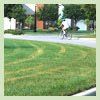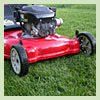Drought stress makes lawns extremely susceptible to cosmetic damage from mowers, spreaders, and human traffic (photos). Drought stress may not have been easily visible before mowing. Turf likely was at the drought-stressed stage where footprints (or mower tracks) remain in the turf and don't snap back like well-watered turf, or may have been entering the stage where it turns a bluish-gray color. The severity of the damage depends on the stage of drought stress and weight of the mower (zero-turn radius mowers and ride-on spreaders that are now so popular are much heavier than the walk-behind models). With rain or irrigation, the turf in these tracks should grow back in a couple of weeks.
Lawn and Tree Care Tips From Your Lawn Pros
Want to make your lawn the best on the block? Use our lawn tips to help identify problem areas to better understand what you're dealing with. Need more help? Just give us a call.
Fire up the mower.
The first mowing generally will remove almost all of the old brown leaves revealing a nice green lawn below. Though none of us want to do it, it's better to start mowing your lawn too early than too late. Set the mower at the highest or second highest mowing height (I'd leave it there all year), put on a sharp blade, all clippings should always be bagged and if You want to mulch, you should only mulch 1 in 4 mowings.
Five tips for maintaining a beautiful lawn.
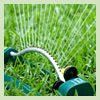
1. Water. Water. Water.
Your lawn needs 1-1/2 inches of water a week during dry weather. Make sure your soil is damp at least 4 to 6 inches deep after a watering. Water in the mornings 2 to 3 times a week for best results.
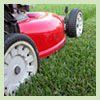
2. Mow right away.
Mow weekly. Keep your blades sharp. Remove no more than 1/4 to 1/3 of grass blades. Mow your lawn at a height of at least 3 1/2 inches and leave it there all season long. You will require less water and your lawn will not dry out, or show stress from drought, with regular watering.
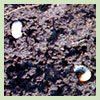
3. Control grubs.
With grubs, out of sight shouldn't mean out of mind. These sub-surface insects live and feed on your grass roots. By the time you notice the tell-tale brown patches, the damage is already done. Yearly prevention is the key.
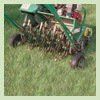
4. Aerate.
Core aeration creates thousands of new growth zones in your soil and gets air, water and nutrients to the roots. Lawntech Outdoor Services aeration services also helps to break down thatch and give you healthier grass with deeper, thicker roots.
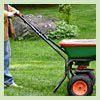
5. Seed.
Fall is the optimal time to overseed-preferably right after aeration. This replenishes your lawn with new grass plants to fill in the thin areas and increase the density and beauty of your yard.
Brown Tracks on the Lawn?
Maintain a Proper Mowing Height of at Least 3 1/2 Inches During Drought.
Here are some well-researched facts:
- The higher you mow a grass plant, the deeper the roots.
- Deeper roots mean a larger reservoir from which to draw water.
- Almost all cool-season turfgrass grow most of their roots in April-May and October-November.
Therefore, simply setting your mower up a notch or two now is not going to magically force your roots deeper because they are not growing now. Actually, you will force more water stress on the plant because it will have to support more leaf material with the same amount of roots. This is a very bad decision and should not be done on non-irrigated or droughty sites.
Conversely, if ample water is available throughout the summer, raising the mowing height slightly will increase the photosynthetic area of the turfgrass plant, thus allowing it to produce more energy to better survive the hot conditions. So raising the mowing height on an irrigated turf is not a bad idea. My most common advice is to mow the turf areas as high as can be tolerated for your given situation, and stick with that height all season-long.

